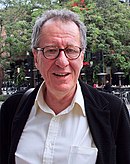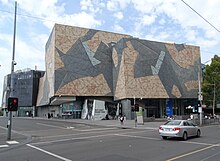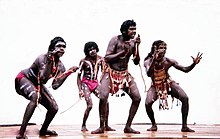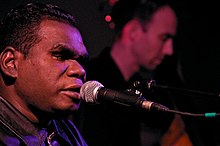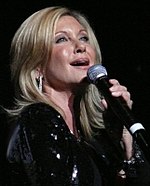Arts in Australia
Australian cinema has a long tradition with a body of work producing popular classics such as Crocodile Dundee and The Man From Snowy River, and arthouse successes such as Picnic at Hanging Rock and Ten Canoes.
Prominent Australian trained filmed artists include Errol Flynn, Mel Gibson, Nicole Kidman, Russell Crowe and Cate Blanchett.
[1][2][3] At the close of the 19th century, the painters of the Heidelberg School began to capture the unique colours of the Australian bush, famed writers Henry Lawson and Banjo Paterson presented conflicting views of the harshness and romance of life in Australia, and performing artists like opera singer Dame Nellie Melba made a mark internationally in classical European culture.
Australia's capital cities each support traditional "high culture" institutions in the form of major art galleries, ballet troupes, theatres, symphony orchestras, opera houses and dance companies.
Leading Australian performers in these fields have included the opera Dames Nellie Melba and Joan Sutherland, dancers Edouard Borovansky and Sir Robert Helpmann, and choreographer/dancers such as Graeme Murphy and Meryl Tankard.
Artists such as Arthur Streeton, Frederick McCubbin and Tom Roberts applied themselves to recreating in their art a truer sense of light and colour as seen in the Australian landscape.
Among the principal Australian artists of the 20th century are the surrealists Sidney Nolan, Arthur Boyd and Russell Drysdale, the avant-garde Brett Whiteley, the painter/sculptors William Dobell and Norman Lindsay, the landscapists Emily Kame Kngwarreye, Albert Namatjira and Lloyd Rees, and modernist photographer Max Dupain.
Ricky Swallow, Patricia Piccinini, Susan Norrie, Callum Morton, Rover Thomas and Emily Kame Kngwarreye have all represented Australians at the Venice Biennale using the traditional mediums of sculpture, photography and painting while instilling them with a renewed vigour.
During the late 1960s and 1970s an influx of government funding saw the development of a new generation of filmmakers telling distinctively Australian stories, including directors Peter Weir, George Miller and Bruce Beresford.
as a golden age of Australian cinema, with many successful films, from the historical drama of Gallipoli (1981) to the dark science fiction of the Mad Max sequels (1981–85), the romantic adventure of The Man From Snowy River (1982) or the comedy of Crocodile Dundee (1986).
A number of thrillers and horror films dubbed "outback gothic" have been created, including Wake in Fright, Walkabout (1971), The Cars That Ate Paris (1974) and Picnic at Hanging Rock (1975), Razorback (1984) and Shame (1988) in the 1980s, and Japanese Story (2003), The Proposition (2005) and the world-renowned Wolf Creek (2006) in the 21st century.
The 1990s saw a run of successful comedies such as Strictly Ballroom (1992), Muriel's Wedding (1994) and The Castle (1996), which helped launch the careers of Toni Collette, P. J. Hogan, Eric Bana and Baz Luhrmann.
This group was joined in Hollywood by actors including Russell Crowe, Cate Blanchett and Heath Ledger who also rose to international prominence.
Notable contemporary expatriate authors include the feminist Germaine Greer, art historian Robert Hughes and humorists Barry Humphries and Clive James.
At one point, Lawson and Paterson contributed a series of verses to The Bulletin magazine in which they engaged in a literary debate about the nature of life in Australia.
Traditional ritual performances define roles, responsibilities and country, giving an understanding of people's relationship with social, geographical and environmental forces.
This wooden instrument, used amongst the Aboriginal tribes of northern Australia, makes a distinctive droning sound and its use has been adopted by a wide variety of non-Aboriginal performers.
Geoffrey Gurrumul Yunupingu (formerly of Yothu Yindi) has attained international success singing contemporary music in English and in the language of the Yolngu.
[31] Other well-known singers of Australian folk music include Rolf Harris (who wrote "Tie Me Kangaroo Down Sport"), John Williamson, and Eric Bogle whose 1972 song "And the Band Played Waltzing Matilda" is a sorrowful lament to the Gallipoli Campaign.
[35] The establishment of choral societies (c. 1850) and symphony orchestras (c. 1890) led to increased compositional activity, although many Australian classical composers attempted to work entirely within European models.
[34] In the war and post-war eras, as pressure built to assert a national identity in the face of the looming superpower of the United States and the "motherland" Britain, composers looked to their surroundings for inspiration.
John Antill[36] and Peter Sculthorpe began to incorporate elements of Aboriginal music, and Richard Meale drew influence from south-east Asia (notably using the harmonic properties of the Balinese Gamelan, as had Percy Grainger in an earlier generation).
[citation needed] During the 1970s, 1980s and 1990s Australian performers continued to do well on the local and international music scenes, for example Cold Chisel, INXS, Men at Work and Kylie Minogue, Natalie Imbruglia, Savage Garden and Silverchair.
In the early 21st century, bands such as Jet, Wolfmother, Eskimo Joe, Grinspoon, The Vines, The Living End, Pendulum, Delta Goodrem and others were enjoying success internationally.
[41] Dusty recorded and released his one-hundredth album in the year 2000 and was given the honour of singing Waltzing Matilda in the closing ceremony of the Sydney 2000 Olympic Games.
Other popular performers of Australian country music include: John Williamson (who wrote the iconic song "True Blue"), Lee Kernaghan, Kasey Chambers and Sara Storer.
In the United States, Australian country music stars including Olivia Newton-John and Keith Urban have attained great success.
The ceremonial dances of indigenous Australians which recount the stories of the Dreamtime, comprise theatrical aspects and have been performed since time immemorial during the 40–60,000-year Aboriginal occupation of Australia.
[43] Two centuries later, the extraordinary circumstances of the foundations of Australian theatre were recounted in Our Country's Good by Timberlake Wertenbaker: the participants were prisoners watched by sadistic guards and the leading lady was under threat of the death penalty.
It is an example of the contemporary fusion of traditions of drama in Australia with Pitjantjatjara actors being supported by a multicultural cast of Greek, Afghan, Japanese and New Zealand heritage.






